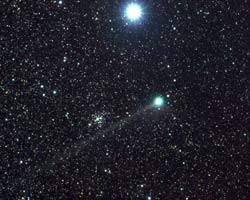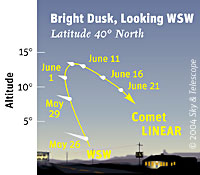
On May 22, 2004, Comet LINEAR passed near the open star cluster M41 in Canis Major. Sirius is the bright star at the top of the frame. The image was shot at Hakos Farm in Namibia.
Courtesy Michael Jäger and Gerald Rheman.
Until late June, Northern Hemisphere observers can catch both Comets NEAT and LINEAR before they become difficult (or impossible) to observe. LINEAR (C/2002 T7) emerged from the Sun’s glare in late May, and by early June had faded to about 4th magnitude. At this time its head was approximately 10 arcminutes wide, followed by a 1°-long tail. The comet is expected to fade to 9th magnitude by the end of June as it moves away from both the Earth and the Sun. It will also move lower in the evening sky throughout June until, in early July, it becomes unobservable from the Northern Hemisphere.

Sky & Telescope illustration.
You can use our interactive sky chart to find Comet LINEAR in the dusk skies of the
Northern Hemisphere
during June 2004. The chart is set to 10:05 p.m. starting on June 1st at 40° north. To adjust the date and time, highlight the month, day, hour, or minute and click the "+" or "-" button. To alter your viewing location, press the "Change" button on the location bar.
Meanwhile, Comet NEAT (C/2001 Q4) glowed at magnitude 5.4 as of June 2nd, with a 10-arcminute-wide head and a 30-arcminute-long tail. This comet will likely fade to 7th magnitude by the end of the month, though it will remain high in the sky near Merak, the bottom-right star in the bowl of the Big Dipper.
Our interactive sky chart will also show Comet NEAT as it moves through
Ursa Major
during June and July 2004. The chart is set to 10:00 p.m. starting on June 15th at 40° north.
The past three years have each seen a comet of brightness comparable to that of NEAT and LINEAR, but not two at once. (The comets were C/2002 V1 NEAT, which peaked in February 2003 at magnitude 3.0, 153P/2002 C1 Ikeya-Zhang in April 2002 at magnitude 3.3, and C/2001 A2 LINEAR in June 2001 at magnitude 3.4.) In fact, since 1950, there have been only three other instances where two naked-eye comets have graced the sky simultaneously, and all three pairs were dimmer, between 5th and 6th magnitude.
 0
0
Comments
You must be logged in to post a comment.